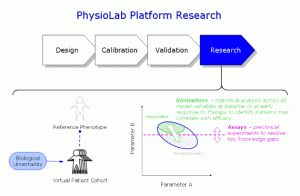 PhysioLab® Platform and Biomarkers: Researchers at the La Jolla Institute have discovered how to use a computer model to mark the biomarkers in the onset of type 1 diabetes.
PhysioLab® Platform and Biomarkers: Researchers at the La Jolla Institute have discovered how to use a computer model to mark the biomarkers in the onset of type 1 diabetes.
Millions of people worldwide suffer from type 1 diabetes, which can lead to severe complications such as renal disease, cardiovascular disease, blindness, coma or death. Researchers believe that the cause of type 1 diabetes comes from the destruction of insulin-producing beta cells in the pancreas. Researchers highly believe if they mark the initial start of type 1 diabetes, they can find a cure for it.
There have been quite a few great advances when it comes to science and medicine. Since the 1920’s when insulin was first discovered, there has been a study created to find a cure for life-long sufferers of type 1 diabetes. From breakthroughs to cures, it seems it has been done once more. A type 1 diabetes researcher from the La Jolla Institute named Matthias von Herrath, M.D. has confirmed the usefulness of a newly established computer model in calculating crucial evidence about nasal insulin management procedures in type 1 diabetes.
This new breakthrough is a very important research tool in type 1 diabetes; the software called Type 1 Diabetes PhysioLab® Platform was developed by Entelos Inc. and it gives researchers the ability to perform lab research faster to evaluate therapeutic strategies for a cure that will work in human patients. It has shown promising results in predicting various data from published type 1 diabetes experiments. The PhysioLab® Platform is an extensive calculated model of disease pathogenesis based on non-obese diabetic mice. It was developed over two years ago and it encourages autoimmune procedures and successive damage of pancreatic beta cells from birth through the onset of diabetes. It was funded by a grant program of the American Diabetes Association.
Dr. Herrath had stated that the model was able to accurately identify the exact timeframe that they key type 1 diabetes information, also known as “biomarkers” surfaced. He explains the biomarkers as proteins or cell types that tell researchers if a therapeutic option is working and when it is time to start a treatment process. When it comes to the La Jolla study, the model showed the ability to positively predict the inception of biomarkers, which revealed beta cell production in a non-obese diabetic mouse. Herrath also stated that the positive results add credibility to the acceptance of assessing computer models to investigate beneficial healing abilities within human diseases.
While interviewing Dr. Herrah he also stated, “Since laboratory studies can cost hundreds of thousands of dollars, and early stage human clinical trials can cost $10 million dollars or more, predicting the right conditions to try is important. We’ve found that using this in silico (computer analysis) prediction platform can quicken the pace and effectiveness of type 1 diabetes research. By allowing us to pre-test our theories in computer models, we can ensure that the more time-intensive and costly process of laboratory testing is focused on the most promising therapeutic strategies, with the greatest chance of success. The model accurately predicted that implementing a low frequency nasal insulin dosing regimen in animal models was more beneficial in controlling type 1 diabetes than a high frequency regimen, noting that the software’s prediction of the biomarkers was key in this process.
“These results confirmed our hypotheses on the benefits of low-frequency nasal insulin dosing. But even more importantly, the advantage of applying computer modeling in optimizing the therapeutic efficacy of nasal insulin immunotherapy was confirmed.”